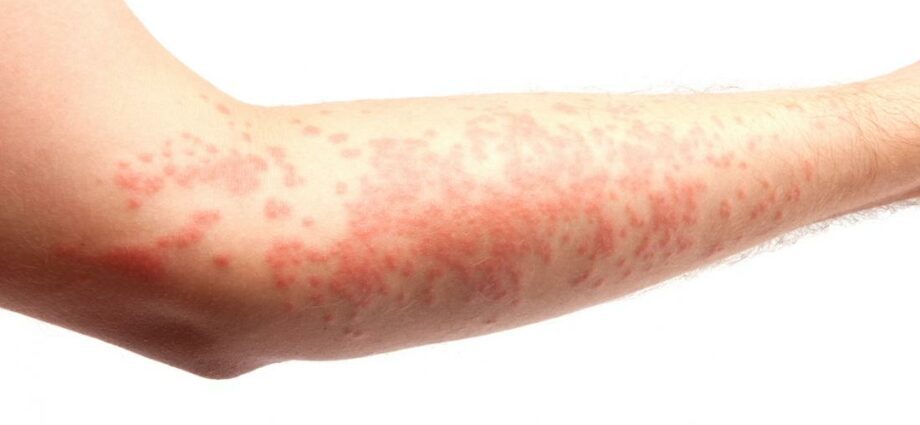Contents
Urticaria: recognizing a hives attack
Definition of urticaria
Urticaria is a rash that is characterized by itching and the appearance of raised red patches (“papules”), which resemble stings of nettles (the word hives comes from the Latin urtica, which means nettle). Urticaria is a symptom rather than a disease, and there are many causes. We distinguish :
- acute urticaria, which manifests itself in one or more relapses lasting a few minutes to a few hours (and may reappear over several days), but progressing for less than 6 weeks;
- chronic urticaria, which results in attacks every day or so, progressing for more than 6 weeks.
When the urticaria attacks are recurrent but not continuous, it is called relapsing urticaria.
Symptoms of the hives attack
Urticaria results in the occurrence of:
- raised papules, resembling stinging nettle, pinkish or red, varying in size (a few millimeters to several centimeters), most often appearing on the arms, legs or trunk;
- itching (pruritus), sometimes very intense;
- in some cases, swelling or edema (angioedema), mostly affecting the face or extremities.
Typically, hives are fleeting (last from a few minutes to a few hours) and go away on their own without leaving scars. However, other lesions can take over and the attack can therefore persist for several days.
In some cases, other symptoms are associated:
- moderate fever;
- abdominal pain or digestive problems;
- joint pain.
People at risk
Anyone can be prone to hives, but certain factors or illnesses can make it more likely.
- the female sex (women are more frequently affected than men3);
- genetic factors: in some cases, the manifestations appear in infants or young children, and there are several cases of urticaria in the family (familial cold urticaria, Mückle and Wells syndrome);
- blood abnormalities (cryoglobulinemia, for example) or a deficiency in certain enzymes (C1-esterase, in particular) 4;
- certain systemic diseases (such as autoimmune thyroiditis, connectivitis, lupus, lymphoma). About 1% of chronic urticaria are associated with systemic disease: there are then other symptoms5.
Risk factors
Several factors can trigger or make seizures worse (see Causes). The most common are:
- taking certain medications;
- excessive consumption of foods rich in histamine or histamino-liberators;
- exposure to cold or heat.
Who is affected by hives attacks?
Anyone can be affected. It is estimated that at least 20% of people have acute urticaria at least once in their lifetime, with women more often affected than men.
In contrast, chronic urticaria is rarer. It concerns 1 to 5% of the population1.
In many cases, people with chronic urticaria are affected for many years. It turns out that 65% of chronic urticaria persist for more than 12 months, and 40% persist for at least 10 years.2.
Causes of the disease
The mechanisms involved in urticaria are complex and poorly understood. Although attacks of acute hives are often due to an allergy, most chronic hives are not allergic in origin.
Certain cells called mast cells, which play a role in the immune system, are involved in chronic urticaria. In affected people, mast cells are more sensitive and trigger, by activating and releasing histamine3, inappropriate inflammatory reactions.
The different types of urticaria
Acute urticaria
While the mechanisms are not well understood, it is known that environmental factors can worsen or trigger hives.
In nearly 75% of cases, the acute urticaria attack is triggered by specific factors:
- a drug triggers the seizure in 30 to 50% of cases. Just about any drug can be the cause. It can be an antibiotic, an anesthetic, aspirin, a nonsteroidal anti-inflammatory drug, a drug to treat high blood pressure, an iodinated contrast medium, morphine, codeine, etc. ;
- a food rich in histamine (cheese, canned fish, sausage, smoked herrings, tomatoes, etc.) or called “histamine-liberating” (strawberries, bananas, pineapples, nuts, chocolate, alcohol, egg white, cold cuts, fish, shellfish …);
- contact with certain products (latex, cosmetics, for example) or plants / animals;
- exposure to cold;
- exposure to the sun or heat;
- pressure or friction of the skin;
- an insect bite;
- concomitant infection (Helicobacter pylori infection, hepatitis B, etc.). The link is not well established, however, and studies are contradictory;
- emotional stress;
- intense physical exercise.
Chronic urticaria
Chronic urticaria can also be triggered by any of the factors listed above, but in about 70% of cases, no causative factor is found. This is called idiopathic urticaria.
Course and possible complications
Urticaria is a benign condition, but it can have a huge impact on quality of life, especially when it is chronic.
However, some forms of urticaria are more worrying than others. This is because hives can be superficial or deep. In the second case, there are painful swelling (edemas) of the skin or mucous membranes, which mainly appear on the face (angioedema), hands and feet.
If this edema affects the larynx (angioedema), the prognosis may be life-threatening because breathing becomes difficult or even impossible. Fortunately, this case is rare.
Our doctor’s opinion
As part of its quality approach, Passeportsanté.net invites you to discover the opinion of a health professional. Dr Jacques Allard, general practitioner, gives you his opinion on theurticaria :
Acute urticaria is a very common condition. Although pruritus (itching) can be bothersome, it can be easily relieved with antihistamines and symptoms go away on their own within hours or days most of the time. If this is not the case, or if the symptoms are generalized, difficult to bear, or reach the face, do not hesitate to see your doctor. Treatment with oral corticosteroids may be necessary. Fortunately, chronic urticaria is a much rarer and more complex disease than acute urticaria. The symptoms can still be relieved in most cases. Dr. Jacques Allard MD FCMFC |










